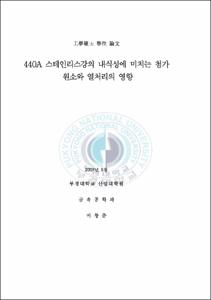440A 스테인리스강의 내식성에 미치는 첨가 원소와 열처리의 영향
- Alternative Title
- The Effect of Alloying Elements and Heat Treatment on the Corrosion Resistance of 440A Martensitic Stainless Steel
- Abstract
- 440A martensitic stainless steels which were modified with reduced carbon content(~0.5%) and addition of small amount of nickel, vanadium, tungsten and molybdenum were manufactured. Effects of alloying elements and tempering temperatures on the uniform and pitting corrosion were investigated through the electrochemical polarization tests.
1. Characteristics of uniform corrosion in 1N H2SO4
①When tempering temperature is constant, corrosion current density in active-passive transition point, Icorr, decreased a little with an increase of austenitizing temperature.
②When austenitizing temperature is constant, longer holding time showed a little lower Icorr and Ipass, passive current density.
③When austenitized at 1050℃ and tempered at 350~750℃, best anti-corrosion properties were obtained at 350℃ tempering temperature while worst at 450℃ and 550℃.
④When tempered at below 450℃ and above 550℃, similar and good anti-corrosion characteristics were obtained regardless of alloying elements added, showing anti-corrosion characteristics are influenced more by tempering temperature than by alloying elements.
2. Pitting corrosion in 3.5% NaCl
①When tempering temperature is constant, the lowest pitting potential, Ep, was obtained when austenitizing temperature was 1250℃ and this is because of the grain coarsening.
②When austenitizing temperature is constant, longer holding time showed a little higher value of Ep.
③When austenitized at 1050℃ and tempered at 350~750℃, the highest Ep was obtained at 350℃, while the lowest at 450℃ and 550℃
④When tempered at 450℃ and 550℃, Ep was increased a little when 0.4wt.% of tungsten was added.
⑤When tempered at 450℃, more pitting was observed. And pitting was formed at regions where Cr concentration is low or grain boundaries are intersecting and showed irregular shape.
- Issued Date
- 2008
- Awarded Date
- 2008. 8
- Type
- Dissertation
- Keyword
- 440A 스테인리스강 내식성 첨가 원소 열처리
- Publisher
- 부경대학교 산업대학원 금속공학과
- Alternative Author(s)
- Lee, Chang Jun
- Affiliation
- 부경대학교 산업대학원
- Department
- 산업대학원 금속공학과
- Table Of Contents
- Abstract = I
1. 서론 = 1
2. 이론적 배경 = 5
2.1 마르텐사이트 스테인리스강의 분류 및 개발 = 5
2.2 마르텐사이트 스테인리스강의 상변태 기초 = 7
2.3 마르텐사이트 스테인리스강의 미세조직과 기계적 성질 = 9
2.4 마르텐사이트 스테인리스강의 내식성에 미치는 열처리의 영향 = 15
2.5 스테인리스강의 부동태와 분극곡선에 미치는 합금 원소의 영향 = 22
2.6 스테인리스강의 공식 = 35
3. 사용재료 및 실험 방법 = 41
3.1 사용 재료 = 41
3.2 열처리 = 41
3.3 전기화학적 분극 시험 = 42
3.4 미세조직 관찰 = 42
4. 실험 결과 및 고찰 = 45
4.1 열처리에 따른 미세조직 = 45
4.2 1N H2SO4 용액에서의 균일부식 특성 = 50
4.2.1 열처리에 따른 분극 곡선과 내식 특성 = 50
4.2.2 합금 원소 첨가에 따른 분극 곡선과 내식 특성 = 60
4.3 3.5% NaCl 용액에서의 공식 특성 = 64
4.3.1 열처리에 따른 분극 곡선과 내식 특성 = 64
4.3.2 합금 원소 첨가에 따른 분극 곡선과 내식 특성 = 73
4.3.3 공식 형태 및 발생에 미치는 열처리 및 합금 원소의 영향 = 78
5. 결론 = 81
참고 문헌 = 82
- Degree
- Master
- Files in This Item:
-
-
Download
 440A 스테인리스강의 내식성에 미치는 첨가 원소와 열처리의 영향.pdf
기타 데이터 / 9.14 MB / Adobe PDF
440A 스테인리스강의 내식성에 미치는 첨가 원소와 열처리의 영향.pdf
기타 데이터 / 9.14 MB / Adobe PDF
-
Items in Repository are protected by copyright, with all rights reserved, unless otherwise indicated.